
A data center or data centre is a building, a dedicated space within a building, or a group of buildings used to house computer systems and associated components, such as telecommunications and storage systems.

NetApp, Inc. is an American hybrid cloud data services and data management company headquartered in Sunnyvale, California. It has ranked in the Fortune 500 since 2012. Founded in 1992 with an IPO in 1995, NetApp offers cloud data services for management of applications and data both online and physically.
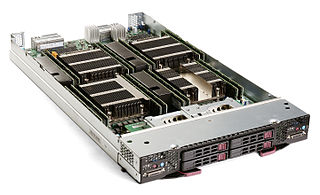
A blade server is a stripped-down server computer with a modular design optimized to minimize the use of physical space and energy. Blade servers have many components removed to save space, minimize power consumption and other considerations, while still having all the functional components to be considered a computer. Unlike a rack-mount server, a blade server fits inside a blade enclosure, which can hold multiple blade servers, providing services such as power, cooling, networking, various interconnects and management. Together, blades and the blade enclosure form a blade system, which may itself be rack-mounted. Different blade providers have differing principles regarding what to include in the blade itself, and in the blade system as a whole.
Wind River Systems, also known as Wind River, is an Alameda, California–based wholly owned subsidiary of TPG Capital. The company develops embedded system and cloud software consisting of real-time operating systems software, industry-specific software, simulation technology, development tools and middleware.

Opsware, Inc. was a software company based in Sunnyvale, California, that offered products for server and network device provisioning, configuration, and management targeted toward enterprise customers. Opsware had offices in New York City, Redmond, Washington, Cary, North Carolina, and an engineering office in Cluj, Romania.
PlateSpin is a software suite of Micro Focus International. Originally a standalone software company headquartered in Toronto, Canada, registered in Delaware, US as Platespin Inc. and founded by Robert Reive in 1999 with co-founders added later David Richards, Bruno Baloi and M. Verdun. Intel corp. via the Intel64fund was a key investor, along with 4Quarters Capital, Castlehill Ventures(Barry Laver) and AltaMira, the latter three all of Toronto, Canada. The original product for which the patent was filed was the Platespin Operations Center, the first usable VM provisioning tool for low cost deployment of servers in their VMs to Vmware ESX and GSX on 64bit processors. Platespin Operations Centre was designed to reduce operations cost and more efficiently use the resources of large servers, as well as deal with routine security patches to software servers and their OS efficiently. Today Platespin is a NetIQ suite of software that helps manage physical and virtualized server workloads on VMware, Microsoft Hyper-V, KVM, Citrix XenServer, Amazon Web Services and Microsoft Azure.

Sun Modular Datacenter is a portable data center built into a standard 20-foot intermodal container manufactured and marketed by Sun Microsystems. An external chiller and power were required for the operation of a Sun MD. A data center of up to 280 servers could be rapidly deployed by shipping the container in a regular way to locations that might not be suitable for a building or another structure, and connecting it to the required infrastructure. Sun stated that the system could be made operational for 1% of the cost of building a traditional data center.

ProLiant is a brand of server computers that was originally developed and marketed by Compaq and currently marketed by Hewlett Packard Enterprise. After Compaq merged with Hewlett-Packard (HP), HP retired its NetServer brand in favor of the ProLiant brand. HP ProLiant systems led the x86 server market in terms of units and revenue during first quarter of 2010. The HP ProLiant servers offer many advanced server features such as redundant power supplies, Out-of-band management with iLO or Lights-out 100, Hot-swap components and up to 8-Socket systems.
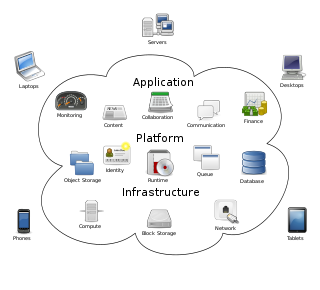
Cloud computing is the on-demand availability of computer system resources, especially data storage and computing power, without direct active management by the user. Large clouds often have functions distributed over multiple locations, each location being a data center. Cloud computing relies on sharing of resources to achieve coherence and economies of scale, typically using a "pay-as-you-go" model which can help in reducing capital expenses but may also lead to unexpected operating expenses for unaware users.
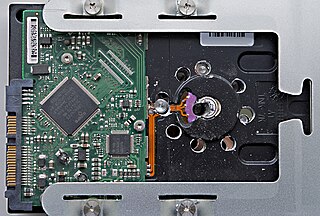
Information technology infrastructure is defined broadly as a set of information technology (IT) components that are the foundation of an IT service; typically physical components, but also various software and network components.

AMAX Engineering Corporation is a privately held technology company based in Fremont, California. Founded in 1979, AMAX specializes in application-tailored cloud computing, data center, deep learning, open-architecture platforms, HPC and OEM solutions.
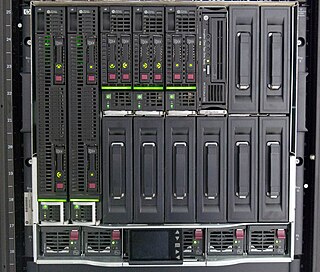
BladeSystem is a line of blade server machines from Hewlett Packard Enterprise that was introduced in June 2006.
Converged infrastructure is a way of structuring an information technology (IT) system which groups multiple components into a single optimized computing package. Components of a converged infrastructure may include servers, data storage devices, networking equipment and software for IT infrastructure management, automation and orchestration.
HP Business Service Automation was a collection of software products for data center automation from the HP Software Division of Hewlett-Packard Company. The products could help Information Technology departments create a common, enterprise-wide view of each business service; enable the automation of change and compliance across all devices that make up a business service; connect IT processes and coordinate teams via common workflows; and integrate with monitoring and ticketing tools to form a complete, integrated business service management solution. HP now provides many of these capabilities as part of HP Business Service Management software and solutions.

Integrated Device Technology, Inc. is an American corporation headquartered in San Jose, California, that designs, manufactures, and markets low-power, high-performance mixed-signal semiconductor solutions for the advanced communications, computing, and consumer industries. The company markets its products primarily to original equipment manufacturers (OEMs). Founded in 1980, the company began as a provider of complementary metal-oxide semiconductors (CMOS) for the communications business segment and computing business segments. The company is focused on three major areas: communications infrastructure, high-performance computing, and advanced power management.
HP ConvergedSystem is a portfolio of system-based products from Hewlett-Packard (HP) that integrates preconfigured IT components into systems for virtualization, cloud computing, big data, collaboration, converged management, and client virtualization. Composed of servers, storage, networking, and integrated software and services, the systems are designed to address the cost and complexity of data center operations and maintenance by pulling the IT components together into a single resource pool so they are easier to manage and faster to deploy. Where previously it would take three to six months from the time of order to get a system up and running, it now reportedly takes as few as 20 days with the HP ConvergedSystem.
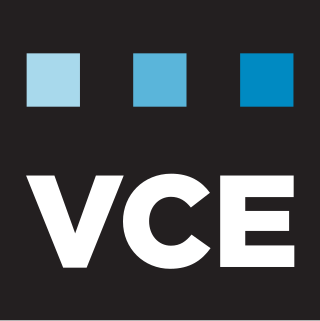
VCE was a division of EMC Corporation that manufactured converged infrastructure appliances for enterprise environments. Founded in 2009 under the name Acadia, it was originally a joint venture between EMC and Cisco Systems, with additional investments by Intel and EMC subsidiary VMware. EMC acquired a 90% controlling stake in VCE from Cisco in October 2014, giving it majority ownership. VCE ended in 2016 after an internal division realignment and subsequent sale of EMC to Dell.

HP Cloud was a set of cloud computing services available from Hewlett-Packard (HP) that offered public cloud, private cloud, hybrid cloud, managed private cloud, and other cloud services. It was the combination of the previous HP Converged Cloud business unit and HP Cloud Services, which is the OpenStack technology-based public cloud. It was marketed to enterprise organizations to combine public cloud services with internal IT resources to create hybrid clouds, or a mix of private and public cloud environments, from about 2011 until 2016.
Stratoscale was a software company offering software-defined data center technology, with hyper-converged infrastructure and cloud computing capabilities. Stratoscale combined compute, storage, and networking hardware with no additional third party software. Stratoscale has shut down with no details for the future of its products.

A micro data center (MDC) is a smaller or containerized (modular) data center architecture that is designed for computer workloads not requiring traditional facilities. Whereas the size may vary from rack to container, a micro data center may include fewer than four servers in a single 19-inch rack. It may come with built-in security systems, cooling systems, and fire protection. Typically there are standalone rack-level systems containing all the components of a 'traditional' data center, including in-rack cooling, power supply, power backup, security, fire and suppression. Designs exist where energy is conserved by means of temperature chaining, in combination with liquid cooling.















